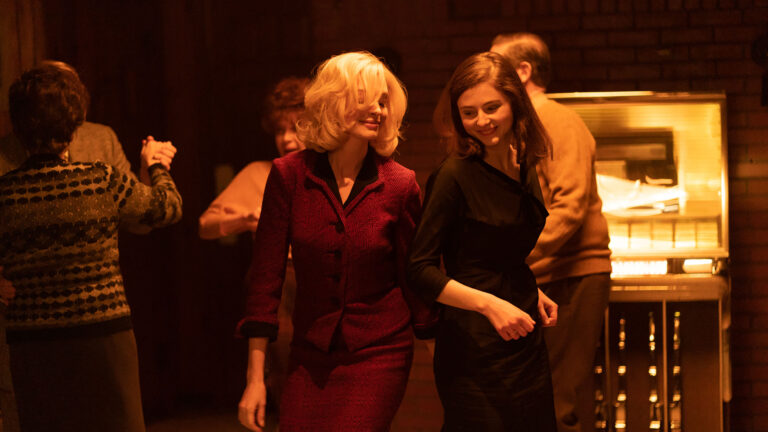Eileen (2023 | USA | 97 minutes | William Oldroyd)
first take: Eileen feels a lot like Carol By The Sea … and then it take a HARD LEFT and becomes something else altogether. Big gasps from packed Sundance house.
For much of its running time, Eileen, adapted from Ottessa Moshfegh’s novel by William Oldroyd (who made a splash for both himself and Florence Pugh with Lady Macbeth), feels like some kind of Carol By The Sea. In the title role, Thomasin McKensie’s mousy prison secretary is quickly enchanted when a psychologist played by a blonde Anne Hathaway arrives in the hardscrabble 1960s New England like a burst of glowing technicolor. Eileen’s in her early twenties, stalled in a dull job in the hometown, taking care of her father who retired from police chief to tolerated town drunk in the wake his wife’s early demise. Her death left a void in both of their lives, but its more pronounced in Eileen’s loneliness, passing days fantasizing about guards at the boys prison where she works and gazing out the window at the facility’s most notorious resident, a stone silent kid who stabbed his own father to death.
Ari Wegner’s cinematography captures the permanent gray of a coastal Massachusetts winter and the claustrophobia of a small town where everyone knows everyone else’s business and is permanently mad about something or other. She also conveys the seismic glamor of a recent Harvard graduate taking over the detention facility for the stodgy old psychologist who’d run the facility for decades. Hathaway’s Dr. Rebecca St. John arrives like a breath of fresh air. A woman unsettling the patriarchal order, her youth and vitality immediately draws Eileen’s notice. The pair strike up a friendship of necessity and we can see how Rebecca fills a number of voids in Eileen’s life: she seemingly has few other friends, her mother died young, and she’s adrift in her life and career. The attentions of a successful, independent, older woman are intoxicating and McKensie communicates a sense of admiring infatuation with each successive interaction. Oldroyd brings us inside her head with flashes of violent fantasies and dreamy imaginings of how her life could take a turn for the better.
The film plays out with this nervous uncertain attraction for a while, never quite tipping its hands as to an explicit relation of what each character wants. Thomasin McKensie has reliably been the best part of any movie she’s been in, but she’s met her match. Doctor St. John is necessarily somewhat of a cipher to the audience, but one gets the sense that Hathaway knows every facet of the life that led the psychologist to this town firmly in mind as the bedrock of her character’s independence and idiosyncrasies. From her professional success to the way she tells off the townies at a bar and dances to the jukebox with wild abandon, it’s easy to understand Eileen’s anxious desire to be both closer to her and to absorb her behaviors and habits with each passing interaction. Like McKensie, we can’t take our eyes off her even if we’re not entirely sure of her intentions.
Just as you think the film is going one direction in cementing the parameters of their relationship, it takes a hard left and becomes something else altogether. From the audible gasps throughout the auditorium, it seemed that — like me — only a minority in the house for its Sundance premiere had read the source material. Often, a big twist from character study to psychological thriller feels cheap, but the change in direction here is well supported by the writing and the powerhouse performances from Hathaway and McKensie. Rather than undermining the previous two acts, it intensifies the sense of Eileen’s desperate longing and the things she’s willing to do to escape.
Eileen premiered in-person at the Sundance Film Festival in the Premieres section where it’s seeking distribution. Header image courtesy Sundance Institute.



